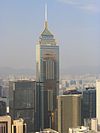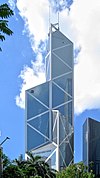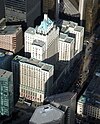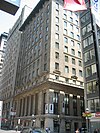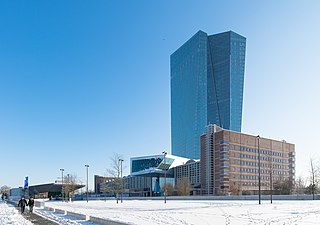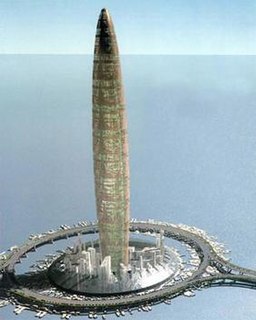It has been requested that the title of this article be changed to List of tallest buildings in the British Empire and the Commonwealth . Please see the relevant discussion on the discussion page. Do not move the page until the discussion has reached consensus for the change and is closed. |
The title of tallest building in the British Empire (later in the Commonwealth) has been contested since the late nineteenth century. In this era the nations of the British Empire possessed a large measure of cultural unity and naturally looked to each other for comparison and competition. This was evident in the displays at Queen Victoria's silver and diamond jubilees and in the creation of the British Empire Games in 1930 (later the Commonwealth Games). A similar phenomenon occurred in the world of architecture and civics. Local boosters in cities and regions across the Empire covered the title of "greatest", "biggest", "largest" or "best" in the Empire.

The British Empire comprised the dominions, colonies, protectorates, mandates and other territories ruled or administered by the United Kingdom and its predecessor states. It originated with the overseas possessions and trading posts established by England between the late 16th and early 18th centuries. At its height, it was the largest empire in history and, for over a century, was the foremost global power. By 1913, the British Empire held sway over 412 million people, 23% of the world population at the time, and by 1920, it covered 35,500,000 km2 (13,700,000 sq mi), 24% of the Earth's total land area. As a result, its political, legal, linguistic and cultural legacy is widespread. At the peak of its power, the phrase "the empire on which the sun never sets" was often used to describe the British Empire, because its expanse around the globe meant that the sun was always shining on at least one of its territories.

The Commonwealth Games are an international multi-sport event involving athletes from the Commonwealth of Nations. The event was first held in 1930, and has taken place every four years since then. The Commonwealth Games were known as the British Empire Games from 1930 to 1950, the British Empire and Commonwealth Games from 1954 to 1966, and British Commonwealth Games from 1970 to 1974. It is the world's first multi-sport event which inducted equal number of women’s and men’s medal events and was implemented recently in the 2018 Commonwealth Games.
Boosterism is the act of promoting ("boosting") a town, city, or organization, with the goal of improving public perception of it. Boosting can be as simple as talking up the entity at a party or as elaborate as establishing a visitors' bureau. It has been somewhat associated with American small towns. Boosting is also done in political settings, especially in regard to disputed policies or controversial events.
Contents
This boosterism was concentrated in Canada where desire to claim the title spurned a race between cities and builders between 1905 and 1931. [1]
In general the boosters focused on commercial buildings, as claiming the title was part of marketing the building to potential renters (and the city to the wider world). They conveniently ignored much taller non-commercial buildings such as St Paul's Cathedral which stands 111 metres (364 ft) and was consecrated in 1708, or Victoria Tower in the Palace of Westminster which was built in 1855 and measures 98.5 metres (323 ft). The Commonwealth of Nations slowly evolved out of the British Empire over decades, but the 1931 Statute of Westminster is often used as a dividing point. During the twentieth century the title was held primarily by Canadian buildings. Since the 1990s, however Asian buildings have held the title.

St Paul's Cathedral, London, is an Anglican cathedral, the seat of the Bishop of London and the mother church of the Diocese of London. It sits on Ludgate Hill at the highest point of the City of London and is a Grade I listed building. Its dedication to Paul the Apostle dates back to the original church on this site, founded in AD 604. The present cathedral, dating from the late 17th century, was designed in the English Baroque style by Sir Christopher Wren. Its construction, completed in Wren's lifetime, was part of a major rebuilding programme in the City after the Great Fire of London. The cathedral building largely destroyed in the Great Fire, now often referred to as Old St Paul's Cathedral, was a central focus for medieval and early modern London, including Paul's walk and St. Paul's Churchyard being the site of St. Paul's Cross.

The Victoria Tower is the square tower at the south-west end of the Palace of Westminster in London, facing south and west onto Black Rod's Garden and Old Palace Yard. At 98.5 metres (323 ft), it is slightly taller than the more famous Elizabeth Tower at the north end of the Palace. It houses the Parliamentary Archives in archive conditions meeting the BS 5454 standard, on 12 floors. All 14 floors of the building were originally linked via a single wrought-iron Victorian staircase of 553 steps, of which five floors survive.

The Palace of Westminster serves as the meeting place of the House of Commons and the House of Lords, the two houses of the Parliament of the United Kingdom. Commonly known as the Houses of Parliament after its occupants, the Palace lies on the north bank of the River Thames in the City of Westminster, in central London, England.
Height restrictions have much to do with this list. Until the 1960s, London, the capital of the Empire, had especially strict height maxima to preserve the views of historic structures. Until the late 1920 Montreal limited all buildings to a maximum of 10 stories, [2] and it still limits buildings to less than the sea-level elevation of Mont Royal. Since 1989 Vancouver restricted buildings from blocking the North Shore Mountains, creating a practical upper limit of around 137 meters, until 1997 when seven sites were pre-selected for taller buildings as exceptions to the rule. [3] Singapore limits all buildings to below 280 meters because of the proximity of Singapore Changi Airport.

London is the capital and largest city of both England and the United Kingdom. Standing on the River Thames in the south-east of England, at the head of its 50-mile (80 km) estuary leading to the North Sea, London has been a major settlement for two millennia. Londinium was founded by the Romans. The City of London, London's ancient core − an area of just 1.12 square miles (2.9 km2) and colloquially known as the Square Mile − retains boundaries that follow closely its medieval limits. The City of Westminster is also an Inner London borough holding city status. Greater London is governed by the Mayor of London and the London Assembly.

The North Shore Mountains are a mountain range overlooking Vancouver in British Columbia, Canada. Their southernmost peaks are visible from most areas in Vancouver and form a distinctive backdrop for the city.

Changi Airport is the major civilian airport for Singapore, and one of the largest transportation hubs in Southeast Asia. It is currently rated the World's Best Airport by Skytrax, for the seventh consecutive year since 2013. It is also the first Airport in the world to do so for seven consecutive years and is one of the world's busiest airports by international passenger and cargo traffic. The airport is located in Changi, at the eastern end of Singapore, approximately 20 kilometres northeast from Marina Bay, on a 13-square-kilometre (5.0 sq mi) site. It is operated by Changi Airport Group and it is the home base of Singapore Airlines, Singapore Airlines Cargo, SilkAir, Scoot, Jetstar Asia Airways and BOC Aviation.
The International Commerce Centre in Hong Kong is not included because it was built after Hong Kong left the Commonwealth.
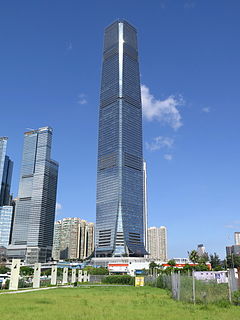
The International Commerce Centre is a 118-storey, 484 m (1,588 ft) commercial skyscraper completed in 2010 in West Kowloon, Hong Kong. It is a part of the Union Square project on top of Kowloon Station. It was the 4th tallest building in the world when its construction was completed in 2010. Now, it is the world's 11th tallest building by height, world's ninth tallest building by number of floors, as well as the tallest building in Hong Kong and also the 6th tallest building within China.
The list also excludes Toronto's CN Tower as there is debate as to whether it is technically a building, or just a structure.

The CN Tower is a 553.3 m-high (1,815.3 ft) concrete communications and observation tower located in Downtown Toronto, Ontario, Canada. Built on the former Railway Lands, it was completed in 1976. Its name "CN" originally referred to Canadian National, the railway company that built the tower. Following the railway's decision to divest non-core freight railway assets prior to the company's privatization in 1995, it transferred the tower to the Canada Lands Company, a federal Crown corporation responsible for real estate development.



